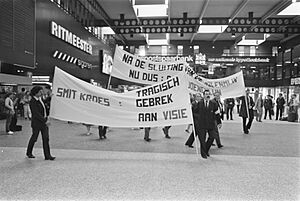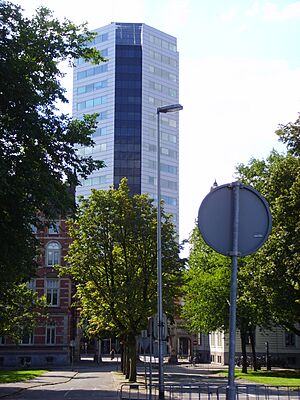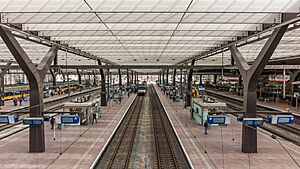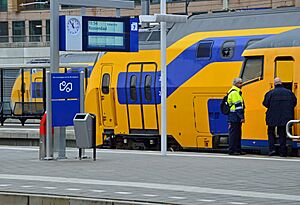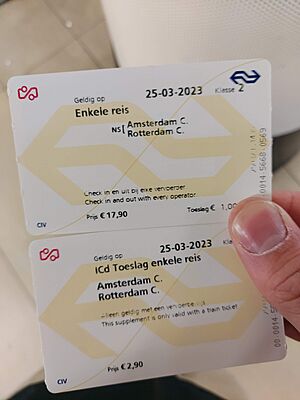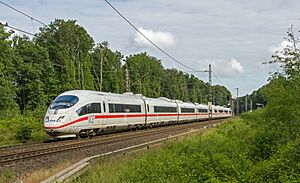Nederlandse Spoorwegen facts for kids
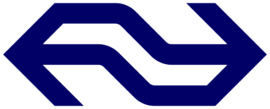 |
|
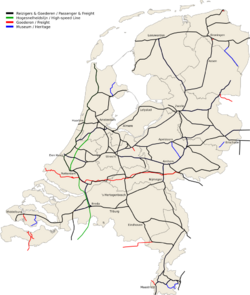
Railway tracks in the Netherlands
|
|
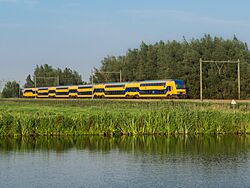
Double decker (DDZ) train near Gouda, South Holland
|
|
| Overview | |
|---|---|
| Locale | Netherlands |
| Dates of operation | 1938–present |
| Predecessor | Hollandsche IJzeren Spoorweg-Maatschappij (HSM) Maatschappij tot Exploitatie van Staatsspoorwegen (SS) |
| Technical | |
| Track gauge | 1,435 mm (4 ft 8 1⁄2 in) standard gauge |
Nederlandse Spoorwegen (which means Dutch Railways), often called NS, is the main company that runs passenger trains in the Netherlands. It is owned by the Dutch government and started in 1938.
NS runs about 4,800 trains every day. These trains carry over 1.1 million passengers across the country. NS also offers international train trips from the Netherlands to other places in Europe. A separate company called ProRail takes care of the railway tracks and signals.
Contents
History of Dutch Railways
How NS Started
After World War I, two big Dutch railway companies, HSM and SS, were losing money. To avoid going out of business, they started working together in 1917. The government helped them by buying shares in both companies.
In 1938, the government bought all the remaining shares. This created the new company, NS. NS was not fully taken over by the government at that time.
Challenges and Changes
During World War II, NS was forced to build railways to a camp called Westerbork transit camp. They also had to transport many people to other camps. NS went on strike during a severe food shortage in 1944–45.
After the war, NS was very important for rebuilding the Netherlands. Trains were the main way to move goods and people. However, in the 1960s, more people started using cars and other transport. This made NS lose money.
The company tried to improve things with a plan called Spoorslag '70. This plan added more trains and introduced faster "intercity" services. Even with these changes, NS still needed money from the government.
Modern Reforms
In the 1980s and 1990s, NS changed a lot. The government wanted railway companies to be more independent. This meant NS would get less money from the government.
The part of NS that managed tracks was separated and became NS Railinfratrust. Other parts of NS were also split up. These included NS Reizigers (for passengers) and NedTrain (for train repairs). The freight part, NS Cargo, joined with a German company called DB Cargo.
After these changes, train services sometimes got worse. There were also strikes. Because of these problems, the leaders of NS all left in 2001.
Getting Back on Track
A new leader, Karel Noordzij, took over in 2002. He changed many things to make the company better. The government decided that having many companies competing for passenger service was not working well.
So, NS was given a special agreement to run most main train lines until 2025. This helped bring back trust in the company.
In 2006, NS changed its timetable to match other European countries better. This made it easier for international trains.
The COVID-19 pandemic caused fewer people to travel by train. NS received financial help from the government to keep running. In 2022, NS had fewer staff, so they had to run fewer and shorter trains.
Where NS Trains Go
NS trains cover most of the Netherlands. Almost all cities are connected. Many places have trains every 30 minutes or more often. The five biggest cities (Amsterdam, Rotterdam, The Hague, Utrecht, and Eindhoven) have at least four trains per hour.
Trains usually run from 5:00 AM to 1:00 AM. There is also a special night train service. This service connects major cities in the Randstad area all night long. On weekends, it also connects some big cities in North Brabant.
NS also works with other companies for international trips. For example, they partner with KLM for the Intercity Direct service to Breda and Brussels. Other international services like Eurostar and Intercity-Express are part of NS International.
The Main Rail Network
The hoofdrailnet is the main passenger rail network in the Netherlands. NS has an agreement to run all passenger services on this network until January 1, 2034.
On most of these lines, NS is the only operator. However, on some parts, other companies like Arriva or Breng also use the tracks. This does not mean they compete on the same lines.
The agreement requires NS to serve main stations at least twice an hour. Other stations must be served at least once an hour. This is from 6 AM to midnight, except on New Year's Eve.
New rules for trains include having toilets on trains. By 2025, every train on the main network must have a toilet.
Kinds of Train Services
NS offers three main types of train services:
- A Sprinter stops at every station. These trains are mainly for local travel. On some smaller lines, the Sprinter is the only train service available.
- Intercity trains only stop at larger stations. They were started in the 1970s to provide fast connections across the country. Intercity trains are usually faster because they skip smaller stops.
- The Intercity Direct service is even faster. It connects Amsterdam Centraal and Breda using a high-speed line. It only stops at Schiphol Airport and Rotterdam Centraal. You need to pay a small extra fee for this service if you travel on the high-speed part.
There were also two older types of trains, but NS does not use these names anymore:
- Stoptrein (Stopping train): This was the old name for Sprinter trains. Some private train companies still use this name.
- Sneltrein (Fast train): NS stopped using this name in 2008. These services are now called 'Intercity' trains.
Tickets and Fares
You can pay for train travel in the Netherlands using contactless payments. You can use your smartphone or bank card directly. Just tap it on the reader to check-in at the start of your trip. Tap again to check-out when you finish. This works for all domestic trains, metros, trams, and buses.
The OV-chipkaart is another common way to pay. This is a special public transport chip card. You can buy single or return paper tickets at machines, but they cost a little extra. You can also buy e-tickets online.
When you travel, you must always "check-in" at the start of your journey and "check-out" at the end. If you switch to another train company, you need to check out with the first company and then check in with the new one.
Discount Passes
NS offers discounts for traveling during "off-peak" hours. These are weekdays from 9:00 AM to 4:00 PM and from 6:30 PM to 6:30 AM the next morning. All day on Saturdays and Sundays are also off-peak. If you have a special discount pass on your OV-chipkaart, the discount is applied automatically.
NS Logo
The NS logo was created in 1968. It is seen everywhere on trains and at stations in the Netherlands. The logo is a wide letter 'N' and a sideways 'S' shape.
The two arrows in the logo show the train's movement. The two lines in the middle represent the train tracks. The logo is usually blue or black on a dark yellow or white background. NS trains and stations often use these same colors.
Parts of NS
NS is made up of several important parts:
- Abellio – This part of NS runs train services outside the Netherlands. It has operated train lines in the United Kingdom and Germany.
- NS Reizigers (NSR) – This is the main part that handles passenger train services. It also employs train drivers and conductors.
- NS Stations – This part manages all 404 railway stations in the Netherlands. It also develops areas around stations, like offices and apartments.
- NedTrain – This part is responsible for maintaining and repairing trains.
- NS International – This part works with other companies to run international trains. These include trains like Thalys to Paris, ICE to Germany, and Intercity Direct to Brussels.
When you deal with NS, you usually just hear "Nederlandse Spoorwegen" or "NS." The different parts work together.
Policies and Services
NS has a system for refunds if your train is delayed. If your journey is delayed by 30 minutes or more, you can get some money back. If it's delayed by an hour or more, you can get the full ticket price back. This does not apply to very short trips or delays that were announced beforehand.
Smoking is not allowed on trains or at stations. This rule has been in place since 2004 for trains and since October 2020 for stations.
Years ago, you could buy coffee, snacks, and drinks on domestic trains. But this stopped in 2003 because there were more shops at stations. Also, most train trips in the Netherlands are quite short. Now, a smaller service called RailTender offers drinks and snacks on some longer journeys.
Technology for Staff
Train conductors use smartphones with timetables and fare information. They also have a special card reader for the OV-chipkaart.
Train drivers use a tablet with an app called "TimTim." This app helps them save energy and stay on schedule. It also lets them see other trains nearby.
Train Travel Facts
In 2018, the number of NS passengers grew by almost 3 percent. On average, 1.3 million people took the train on a weekday. This was 100,000 more than in 2016. The more than 250 NS train stations are becoming busier.
See also
 In Spanish: Nederlandse Spoorwegen para niños
In Spanish: Nederlandse Spoorwegen para niños
- Dutch railway services
- Rail transport in the Netherlands
- Railway stations in the Netherlands
- Train routes in the Netherlands
- Trains in the Netherlands



